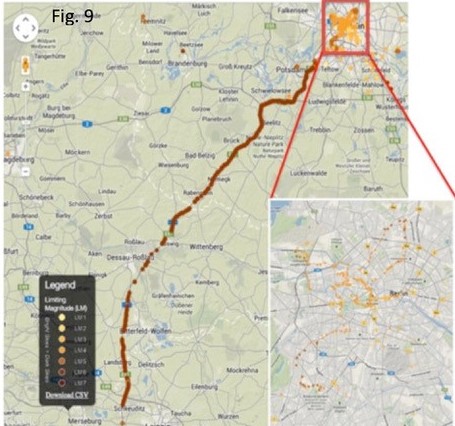GAM 2018 Blog
Preserve your Natural Heritage: Measure Sky Brightness on Moonless Evenings with Globe at Night Citizen-Science
 Tilly Evans
Tilly Evans- Published: Thursday, April 05 2018 09:00
By Connie Walker
Citizen-science is a rewardingly inclusive way to bring awareness to the public on the disappearance of the starry night sky, its cause and solutions. Globe at Night (GaN) encourages citizen-scientists worldwide to record the brightness of the night sky. During ten-days per month of moonless evenings, children and adults match the appearance of a specific constellation with 7 star maps of progressively fainter stars found at www.globeatnight.org. (Moonless evenings are chosen to avoid having a natural light bulb in the night sky when taking measurements.) People then submit their choice of star map in-situ using the “webapp” on a smart device. In twelve years of the program, over 175,000 observations from 180 countries have been contributed to a light pollution map.
Resources for GaN exist to make participation easy. There are 4 ways of taking measurements. The online app for data reporting is in 26 languages. On-the-fly mapping enables citizen-scientists to see observations immediately. STEM activities for young children and problem-based learning activities for older students were created to experience real-life scenarios: role-playing sea turtles hatching (misdirected by lights on shore) or analyzing an ISS image of Houston to estimate the wasted energy, cost and carbon footprint. In-situ and online workshops have been given on using GaN, as well as the activities. Our Facebook page exists to encourage dialogue and bring cutting-edge news. To entice interest, we had monthly newsletters and serial podcasts starring the Dark Skies Crusader.
There are many potential uses of the open Globe at Night database. Participants can explore the last 12 years of data using the Globe at Night interactive map or see how many measurements are from a particular city, using Globe at Night’s map app. The database has been used to explore how light pollution affects the foraging habits of bats using data from the Arizona Game and Fish (Fig. 1), or the habitats of night birds using data from the Audubon Society (Fig. 2). It also has been used by students to study different methods for studying night sky brightness (Fig. 3) or to study seasonal trends in nightly sky brightness averages within a city compared to mountaintop observatories (Fig. 4). The data was used to estimate how much brighter a city sky is than a naturally unpolluted starry sky. In Fig. 5, students visualized their 3700 Globe at Night data points as a 35,000 piece lego map, higher layers as higher limiting magnitudes. With their data, they calculated a factor of 9 compared with a limiting magnitude (LM) 6 sky. In Fig. 6, Tucson was a factor of 100 brighter compared with an LM 7 sky. Dark sky advocates in Figures 7 and 8 used measurements to strengthen lighting laws. Communities in Figures 9, 10 and 11 make a difference by monitoring their night sky brightness levels year after year.
We have built a community of practitioners in various ways worldwide and have metrics on behavioral changes. GaN has been part of special campaigns like with the National Park Service, the National Geographic BioBlitz and Tucson in 2011. In 2009 and 2015, Globe at Night was an official citizen-science campaign for the United Nation-sanctioned International Years of Astronomy and of Light, respectively, setting record participation. To maintain the community and create new partnerships, we have teamed with SciStarter to track participants via a dashboard, with the Girl Scouts and SciStarter in “Think Like a Citizen Scientist”, and with STARS4ALL’s Light Pollution Initiatives.
Globe at Night has provided the public with a variety of ways to be better stewards in lighting more responsibly to minimize the disappearance of our potentially starry night sky. Globe at Night is a flagship program of the National Optical Astronomy Observatory (NOAO). NOAO is the U.S. national observatory operated by the Association of Universities for Research in Astronomy, Inc. under cooperative agreement with the National Science Foundation.
We invite you to participate in Globe at Night this Global Astronomy month. We further invite you to join us all year next year for the International Astronomical Union’s 100th year anniversary by taking Global at Night measurements during any of the monthly 10-day campaigns. Your Globe at Night measurements will help make a difference in preserving our night sky heritage.
(See the photo montage that follows.)
 |
|
  |
|
 |
|
  |
|
  |
|
  |
|
 |
|
Image Credits:
Figure 1. Alisa Fersch (and Connie Walker)
Figure 2. Don Swann
Figure 3. John Kanemoto and Amy Juan (and Connie Walker)
Figure 4. Rachel Nydegger (and Connie Walker)
Figure 5 Chuck Bueter
Figure 6. Connie Walker and Jeremy White
Figure 7. Data taken by Eileen Gryzbowski and colleagues; map by Connie Walker
Figure 8. Roland Dechesne
Figure 9. Data taken by Chris Kyba; map by Connie Walker
Figure 10. Data taken by Astrobaza students in Poland; map by Connie Walker
Figure 11. Data taken by Montevideo, Uruguay residence; map by Connie Walker
Connie Walker is an astronomer at the National Optical Astronomy Observatory in Tucson, Arizona, USA. During the past 17 years, she has enjoyed directing several education outreach programs, such as the popular international light pollution citizen-science campaign Globe at Night and the middle school “problem-based learning” activities in the Quality Lighting Teaching Kit. She is vice-president of the International Astronomical Union’s commission on light pollution and chair of the education committee for the board of directors of the International Dark-Sky Association. For her efforts in bringing dark skies awareness to the public, the IDA awarded her their Hoag-Robinson Award in 2011.








